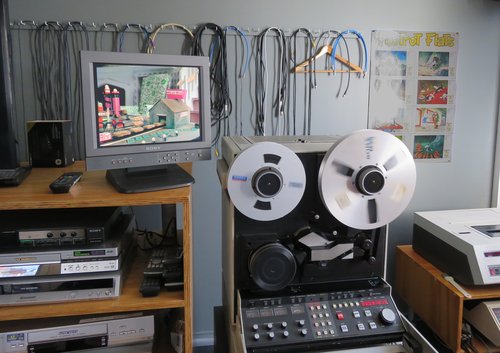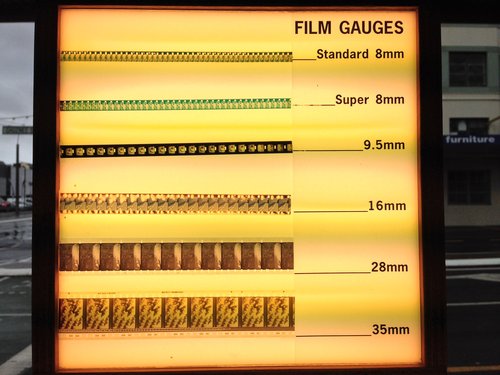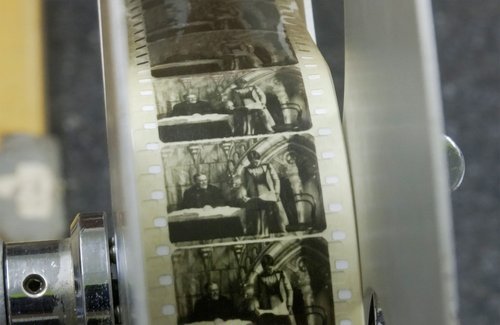
I tēnei whārangi On this page
Storage conditions
Audiovisual material is best kept in a cool, dry, dark and clean environment. Temperatures below 18°C and relative humidity of 35-45% are preferable. Light, magnetic fields, vibrations and pests can also damage audiovisual media. The most important thing is consistency and low humidity, so in a typical home environment, avoid storing audiovisual items in attics or basements or near showers or other heat or humidity sources. A cool, dark place like a closet or under a bed is often a good choice.
Film should be stored horizontally in rust-free cans. The film should not be wrapped in plastic and the lid of the can should be slightly loose to avoid condensation and prevent decomposition gases from building up. While it is usually ok to stack a small number of cans, be wary of the weight as cans may buckle. When stored and handled correctly, film can last over 100 years! To find out more information, we recommend the FilmCare.org resources.
Magnetic tape media (including VCR, cassette tape, open reel tape, Betacam and DV cam) as well as optical disks (CDs, DVDs) should be stored upright, on the long edge of the carrier. Keep them in a clean, non-airtight container and avoid stacking tapes on top of each other. Magnetic media has a relatively short lifespan, even in the best storage conditions. The National Film and Sound Archive of Australia’s Deadline 2025 report advises digitising magnetic media urgently to avoid losing content.

Nitrate film
Nitrate film is classed as a hazardous substance due to its flammable nature and requires specialist storage conditions.
Nitrate film can be difficult to distinguish from acetate film but some indicators are:
- It may have ‘nitrate’ written on the edge, though this doesn't guarantee it is nitrate. Sometimes this text was carried through to acetate copies of nitrate film.
- Nitrate film is only ever 35mm wide (it was never made in other gauges).
- Nitrate was only in circulation until 1951. Be mindful that acetate film was also used before 1951, and some early films were reprinted onto acetate.
Ngā Taonga has a nitrate vault and specialist preservation archivists, so we can house nitrate on your behalf. If you suspect you have nitrate film, please get in contact with us promptly.
To find out more about our nitrate, read more about it here or watch how we preserve it here.

Damaged media
When kept in warm, humid climates, film may become warped, brittle and emit a sharp vinegar smell. If you detect a sharp vinegar smell you should seek specialist advice immediately. The films will need to be copied, as the acetic acid will be destroying the picture.
Mould often grows on film and tape that is kept in humid climates. If you do find mould on your film or tape, you can very carefully clean it off the top and bottom surfaces of the film reel with isopropyl alcohol (available in a pharmacy) and cotton buds. Be careful not to soak the film in alcohol. It may take a few attempts to remove the mould entirely. Then seek specialist advice about having the film copied, as the enzymes may already be eating into the film and destroying the picture.
If you discover mould on a tape enclosed in a cassette, we recommend seeking professional help rather than attempting to clean it yourself. Opening a cassette may cause the tape to unspool and get damaged, and you may be in danger of inhaling toxic mould.
If your audiovisual material has been damaged by fire, flood or earthquake, please contact us for advice.

Digitisation
While we can slow the physical deterioration of audiovisual media, we cannot stop it completely. Digitisation is the best way to preserve content on analogue media. Be aware there is also a decreasing availability of digitisation equipment and technicians, so the earlier you digitise the better. There are risks involved with digitisation – fragile media can be damaged during transit or in playback. You may only have one opportunity to digitise.
Ngā Taonga runs a digital preservation programme for the collections in our care, but there are a number of commercial digitisation services. Ngā Taonga cannot specifically recommend vendors, but a quick online search for ‘film transfer’ or ‘video transfer’ will identify your local options.
Here are some considerations before you leave your tapes with them:
- Advise the facility if the material has mould, so their staff and equipment can be kept safe.
- Ask what process the tapes undergo before digitisation? Are they cleaned? With chemical agents or by machine?
- Ask what they do if a tape is damaged during transfer? Do they splice it back together?
- Try and get a firm price. For instance, will it cost extra if a tape needs cleaning or repair?
- What kind of files or media will they produce from your tapes?
- Will they ‘clean up’ or restore the picture and sound? Can they show you the before and after?
We recommend keeping the original media after digitisation, as digital files can be lost or corrupted and you may want to re-digitise in future as technology improves.
If you are interested in depositing your material at Ngā Taonga, please see Deposit with us.